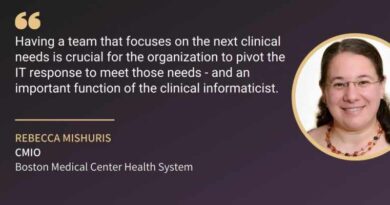Technology and Telemedicine
By Adam Glasofer, MD, MSHI, Associate Medical Director of Informatics, Virtua Health
One can imagine early uses of the telephone involving discussions about patient care between hospitals or a small town contacting a doctor in the city about a patient.
Today, we view telemedicine as the digital exchange of medical information from one site to another with the intended purpose to improve patient care and access. This is achieved through a wide variety of applications, devices, and services. These include things like two-way video, smartphones, email, tablets, peripheral exam devices, and many other mobile tools. All of these tools create a continuum of telemedicine technology complexity.
By leveraging the appropriate telemedicine technology based upon the use case, all of these groups can potentially converge to achieve the quadruple aim by providing better outcomes at lower cost, while, at the same time, improving both the patient and clinician experience.
Telemedicine helps to improve access to care in a way that has the potential to revolutionize the healthcare industry. This is more important than ever as healthcare systems continue to expand their footprint. Enacting telemedicine programs makes location of both patient and facility less important, and allows healthcare providers to expand their reach in ways never previously thought possible. In this article, we will review various telemedicine technologies with regard to complexity and appropriate use in specific cases.
Show patients and providers the benefit these technologies can afford them
In assessing the appropriate technology for a specific telemedicine use case, one must consider budget, use case requirements, and workflow. For basic interactions between provider and patient, mobile devices such as smartphones or tablets work extremely well and are commonplace among both providers and healthcare consumers. These devices allow for secure real-time audiovisual communication from any location with an Internet connection (Wi-Fi, 4G, LTE, etc.). There are multiple mobile-based, HIPAA compliant telemedicine platforms for use on mobile devices that can meet the needs of solo practitioners all the way up to regional healthcare organizations. Secure mobile video carts can also be used in conjunction with mobile devices to allow for similar communications from a health care facility to external locations using stable Wi-Fi or Ethernet connection. These carts provide better quality video than mobile devices as they function over stable internet connections and have a mounted camera that helps to steady the video feed.

The next level of complexity in telemedicine technology is the addition of connected peripheral devices to the audio-visual stream to provide more information for the clinician on the receiving end. The most high-yield and commonly used connected device is the stethoscope, which allows for real-time or store and forward transmission of heart and lung sounds. There are many different types of connected stethoscopes that vary in terms of form, function, and obviously price. Despite variations in price, the costs to implement such a program are not prohibitive to smaller practices or even individual providers. These types of systems can provide large amounts of useful information for a relatively low overall cost. Other connected peripherals include spirometers, otoscopes, ophthalmoscopes, high-resolution cameras, real-time ultrasound probes, EEGs, and various other real-time scopes. Usage of these types of peripherals is dependent upon the needs of the use case.
Also in the category of low complexity telemedicine technology are home monitoring solutions, which includes devices such as blood pressure monitors, scales, glucometers, pulse oximeters, vital sign monitors, wearable fitness devices, and medication dispensers. These devices can provide instant feedback for patients, and allow them to feel more in control of their health while at the same time allowing clinicians to remotely monitor them. Data from these devices can be synched to software platforms with algorithms to alert for certain events or findings. This information can then be sent along to the native electronic health record to allow clinicians to view this information in-line with the comprehensive medical record. Included in home monitoring devices are also cardiac telemetry devices that allow for remote intermittent or continuous monitoring of cardiac status. Aside for providing comfort to the patient, these devices can reduce the need for in-hospital monitoring in stable cardiac patients. With the emergence of new mobile solutions within this market, cardiac telemetry devices are more accessible than ever as they have cut down on previously cumbersome remote options.
As we approach higher complexity telemedicine technology, we start to see more of an “all in one” approach with devices that have enhanced mobility and can perform multiple aspects of a physical exam via telepresence technology and connected peripheral devices. Peripheral integrated carts are often used in hospital settings as they offer reliable video quality and a robust suite of peripherals and add-ons. Some models can even be driven remotely so that providers can “round” from a remote location. On the other hand, mobile integrated telemedicine kits allow either patients or health care providers to perform remote physical exams using mobile devices that have a variety of add-on attachments that allow for capture of various physical exam elements. These units are becoming more commonly used as they are affordable, allow for flexibility, and are relatively easy to use. There are various offerings of these kits that are targeted to different use cases: rugged for field use (disasters, EMS, etc.), small and compact for consumers, and those with increased durability and higher quality parts for healthcare professionals.
Atop the mountain of telemedicine technology complexity are the emerging technologies of AR and VR. VR platforms allow for creation of a completely immersive auditory and visual environment to create a world that can be based in reality or devoid of physical laws governing space, time, mechanics, etc. VR’s ability to manipulate the user world can be helpful in post-stroke/rehab care, various psychiatric treatments, and simulative learning. It also holds promise for telemedicine application in surgical procedures, radiology, and neuropsychological assessments/rehab. AR functions differently in that it augments the real world with virtual computer-generated objects that appear to the user to coexist in the same space as the real world. This allows for natural movement in the physical world and interaction in the augmented world through gaze, gesture, and voice commands. While the applications of AR are similar to those of VR, it differs significantly in that it is a more natural fit for the clinical workflow as users can still interact with their surroundings.
In order to decide what technology is most appropriate, providers and organizations need to first assess the requirements of the specific use case and then work within their budgeted funds to find the best overall fit to meet the workflow. In doing so, it is vital to do the following when implementing telemedicine technologies:
- Listen to your staff!
- Focus on need first, and not simply what is available or cutting edge.
- Don’t force technology.
- Adapt to current workflows as closely as possible.
- Involve staff early and often.
And perhaps most important is to minimize the pain of implementation, while maximizing the gain. Show patients and providers the benefit these technologies can afford them by meeting them somewhere within their comfort zone so that you can then take them out of it.



